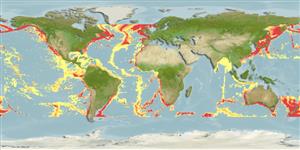>
Notacanthiformes (Halosaurs and deep-sea spiny eels) >
Notacanthidae (Deep-sea spiny eels)
Etymology: Notacanthus: Greek, noton = back + Greek, akantha = thorn (Ref. 45335).
Eponymy: Johann Hieronymus Chemnitz (1730–1800) was a German naturalist, conchologist and theologian. [...] (Ref. 128868), visit book page.
More on author: Bloch.
Issue
Species spelling Paxton et al. 1989 (Ref.7300:150).
Environment: milieu / climate zone / Mức độ sâu / distribution range
Sinh thái học
Biển Sống nổi và đáy; Mức độ sâu 125 - 3285 m (Ref. 58426), usually 128 - 1000 m (Ref. 117245). Deep-water; 61°N - 50°S, 180°W - 180°E
Western North Atlantic: from Labrador to the Gulf of Mexico; Eastern North Atlantic from Iceland and Norway to North Africa (Ref. 130977). Possible in the eastern Indian Ocean: Australia (Ref. 7300) and southwest Pacific: New Zealand (Ref. 5755).
Bộ gần gũi / Khối lượng (Trọng lượng) / Age
Chín muồi sinh dục: Lm ? range ? - ? cm
Max length : 120 cm TL con đực/không giới tính; (Ref. 4449)
Các tia vây lưng cứng (tổng cộng) : 5 - 12; Các vây lưng mềm (tổng cộng) : 2; Tia cứng vây hậu môn: 14 - 17; Tia mềm vây hậu môn: 125 - 145; Động vật có xương sống: 225 - 239. Presence of palatine and dentary teeth in two or more rows. Numerous dorsal spines. Small specimens are pale tan or pale bluish gray, large specimens are dark brown (Ref. 37108).
Body shape (shape guide): elongated.
Benthopelagic (Ref. 58302) and epibenthic (Ref. 58426). Not uncommon in depths around 180 m off Iceland and Greenland. Individuals with nearly ripe eggs have been found in late autumn off Iceland. Mostly found at depths well below 200 m, but enters slightly shallower water on Grand Banks in Canada (Ref. 7251). Feeds primarily on sea anemones (Ref. 4449).
Life cycle and mating behavior
Chín muồi sinh dục | Sự tái sinh sản | Đẻ trứng | Các trứng | Sự sinh sản | Ấu trùng
Sulak, K.J., 1990. Notacanthidae. p. 133-135. In J.C. Quero, J.C. Hureau, C. Karrer, A. Post and L. Saldanha (eds.) Check-list of the fishes of the eastern tropical Atlantic (CLOFETA). JNICT, Lisbon; SEI, Paris; and UNESCO, Paris. Vol. 1. (Ref. 4449)
IUCN Red List Status (Ref. 130435: Version 2025-1)
Threat to humans
Harmless
Human uses
Các nghề cá: không ích lợi (thú vị)
Các công cụ
Special reports
Download XML
Các nguồn internet
Estimates based on models
Preferred temperature (Tài liệu tham khảo
123201): 1 - 14.9, mean 6.1 °C (based on 2531 cells).
Phylogenetic diversity index (Tài liệu tham khảo
82804): PD
50 = 0.5039 [Uniqueness, from 0.5 = low to 2.0 = high].
Bayesian length-weight: a=0.00186 (0.00100 - 0.00347), b=3.07 (2.90 - 3.24), in cm total length, based on LWR estimates for this species & (Sub)family-body (Ref.
93245).
Mức dinh dưỡng (Tài liệu tham khảo
69278): 3.5 ±0.37 se; based on food items.
Generation time: 27.5 ( na - na) years. Estimated as median ln(3)/K based on 2
growth studies.
Thích nghi nhanh (Tài liệu tham khảo
120179): thấp, thời gian nhân đôi của chủng quần tối thiểu là 4.5 - 14 năm (Assuming tmax>10).
Fishing Vulnerability (Ref.
59153): High to very high vulnerability (69 of 100).
🛈
Nutrients (Ref.
124155): Calcium = 9.83 [5.11, 21.37] mg/100g; Iron = 0.259 [0.129, 0.528] mg/100g; Protein = 16.1 [14.9, 17.3] %; Omega3 = 0.274 [0.129, 0.578] g/100g; Selenium = 39.1 [14.6, 106.8] μg/100g; VitaminA = 9.64 [1.93, 48.64] μg/100g; Zinc = 0.376 [0.235, 0.610] mg/100g (wet weight);
